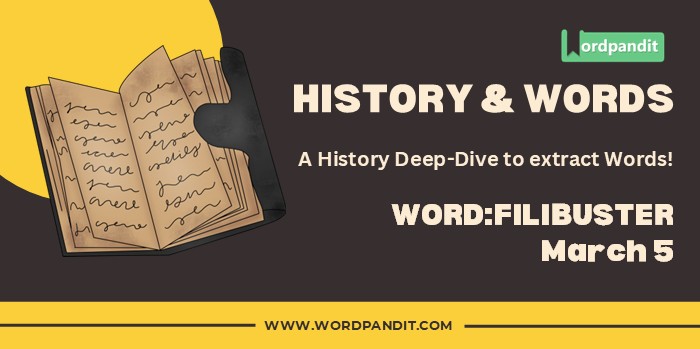History & Words: ‘Filibuster’ (March 5)
Welcome to ‘History & Words.’ 🌟 I’m Prashant, founder of Wordpandit and the Learning Inc. Network. This series combines my passion for language learning with historical context. Each entry explores a word’s significance on a specific date, enhancing vocabulary while deepening understanding of history. Join me in this journey of words through time.
📚 Table of Contents
🔍 Word of the Day: Filibuster
Pronunciation: /ˈfɪlɪbʌstə/ (fill-ih-bus-ter)
🌍 Introduction
On March 5, 1770, the Boston Massacre sparked intense political debates in colonial assemblies, marking one of the earliest recorded instances of extended parliamentary deliberation in American history. This event would foreshadow the development of a powerful legislative tool known as the filibuster, a procedure that would later become synonymous with political obstruction and marathon speeches in the U.S. Senate.
The word “filibuster” represents more than just a parliamentary procedure; it embodies the tension between majority rule and minority rights that has characterized democratic governance throughout history. From its origins as a term for pirates to its modern usage in legislative chambers, the filibuster has evolved to become a crucial element in political discourse and democratic processes.
🌱 Etymology
The term “filibuster” derives from the Dutch word “vrijbuiter” (freebooter) and the Spanish “filibustero,” referring to pirates who plundered the Caribbean in the 17th century. The word’s journey from maritime raiding to parliamentary procedure reflects how the concept of “seizing” or “hijacking” transferred from physical to political contexts in the mid-19th century.
📖 Key Vocabulary
- 🔑 Cloture: A procedure for ending a debate and taking a vote, requiring a three-fifths majority in the U.S. Senate
- 🔑 Dilatory Tactics: Parliamentary procedures used to delay or prevent action on a measure
- 🔑 Standing Filibuster: The traditional form requiring a senator to remain speaking on the floor
- 🔑 Quorum: The minimum number of members required to conduct legislative business
🏛️ Historical Context
The practice of extended debate to obstruct political proceedings dates back to ancient Rome, where Cato the Younger was known for speaking until nightfall to prevent Senate votes. However, the modern filibuster emerged in the unique context of American democracy.
The U.S. Senate’s early rules allowed for unlimited debate, operating under the assumption that senators would exercise this privilege responsibly. This changed as political tensions grew, particularly around issues like slavery and civil rights. The first recognized filibuster in the U.S. Senate occurred in 1837 when a group of Whig senators spoke for several days to prevent allies of President Andrew Jackson from expunging a censure resolution.
The filibuster gained prominence during the Civil Rights era, when Southern senators used it extensively to block civil rights legislation. Strom Thurmond’s record-setting 24-hour and 18-minute speech against the Civil Rights Act of 1957 remains the longest individual filibuster in Senate history.
⏳ Timeline
- 1770: Boston Massacre leads to extended colonial assembly debates
- 1837: First recognized Senate filibuster
- 1917: Senate adopts first cloture rule
- 1957: Strom Thurmond’s record-setting filibuster
- 1975: Senate reduces cloture requirement to three-fifths (60 votes)
- 2013: “Nuclear option” eliminates filibuster for most presidential nominations
- 2017: Filibuster eliminated for Supreme Court nominations
🌟 The Day’s Significance
March 5, 1770, marked not only the Boston Massacre but also the beginning of a tradition of extended political debate in American governance. The colonial assemblies’ response to this crisis demonstrated how deliberative bodies could use prolonged discussion both to obstruct and to ensure thorough consideration of crucial issues.
The aftermath of the Boston Massacre saw colonial representatives engaging in lengthy debates about British authority and colonial rights. These discussions established patterns of political discourse that would influence the development of American legislative procedures, including the filibuster.
The modern significance of March 5 lies in its connection to the emergence of democratic deliberation as a tool for both protection and obstruction. The debates following the Boston Massacre show how extended discussion can serve both to delay action and to ensure careful consideration of important matters.
💬 Quote
“The filibuster is far from a procedural gimmick. It is part of the fabric of this institution and it exists to ensure that legislation earns wide support.” – Senator Chuck Schumer, 2005
🔮 Modern Usage and Reflection
Today, the filibuster remains a controversial element of American democracy. While some view it as a crucial safeguard protecting minority rights, others see it as an obstacle to effective governance. The modern filibuster has evolved from its “talking” origins to a more procedural form, where the mere threat of a filibuster often suffices to block legislation.
🏛️ Legacy
The filibuster’s legacy extends beyond its procedural impact, representing broader questions about democratic governance: How do we balance majority rule with minority rights? When does deliberation become obstruction? These questions continue to shape political discourse and institutional reform debates.
🔍 Comparative Analysis
While the historical filibuster required physical endurance and public speaking stamina, today’s version is more procedural and less dramatic. This evolution reflects broader changes in political institutions, where formal rules often replace personal confrontation and physical demonstrations of commitment.
💡 Did You Know?
🎓 Conclusion
The filibuster, evolving from its roots in piracy to its role in modern governance, remains a powerful symbol of the complex relationship between majority rule and minority rights in democratic systems. Its history, particularly its connection to events like the Boston Massacre, reminds us that the tools of democracy often have complex and sometimes controversial origins.
📚 Further Reading
- 📘 “Filibustering: A Political History of Obstruction in the House and Senate” by Gregory Koger
- 📗 “Politics or Principle? Filibustering in the United States Senate” by Sarah A. Binder and Steven S. Smith
- 📙 “Master of the Senate: The Years of Lyndon Johnson” by Robert A. Caro












